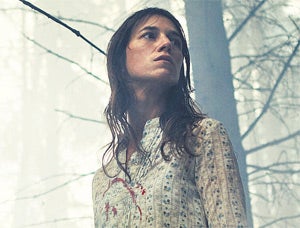Antichrist (18)
What the devil's going on here?

Fainting couches at the ready: here is Lars von Trier's much-heralded shocker.
Having already caused a stir at Cannes, where they love walk-outs and booing almost more than cinema itself, Antichrist had a lot to live up (or perhaps down) to. Whatever you thought of Von Trier's previous work – and I've found most of it eminently resistible – nothing quite prepares you for this bizarre bundle of horror tropes and quasi-religious allusions. It assaults the eye like fragments of a nightmare, its impact undeniable but its meaning largely unfathomable: as with so much of this director's output, the principal motive is to affront.
This is how it goes. A prologue, shot in car-advert black and white and soundtracked by a Handel aria, recounts a domestic tragedy: while a nameless couple make love one night, their toddler climbs to an open window and falls to his death from their high-rise apartment. Poleaxed by guilt and grief, his parents retreat to a remote cabin in the woods – called, with no significance whatsoever, Eden – where they try to come to terms with their traumatic feelings of loss. He (Willem Dafoe), being a therapist, makes it his personal mission to help her (Charlotte Gainsbourg) crawl out from what is obviously a very dark pit of despair. This struggle seems to have touched a personal chord with Von Trier, who has admitted that he wrote the script during a serious bout of depression – it was "a kind of therapy," he said, "a test to see if I would ever make another film." Perhaps that rationale might explain why Antichrist often appears to be on the verge of hysterical breakdown; if this film were a person you would contact the medical services immediately.
At first, the atmosphere in their woodland hideaway is merely brooding. The couple sense their isolation amid nature: falling acorns keep a steady percussive patter on the cabin's roof, predatory birds perch in the trees, lichen stains Dafoe's arm after he leaves the bedroom window open. Meanwhile, his rehabilitation programme on her proceeds uncertainly. They do some therapeutic role-playing, with him as the steady, slightly bullying voice of reason, and her as the unstable patient, always prey to sudden tumultuous bursts of rage. (He's taken her off medication, too). Something, as they say, has got to give, though what form that something will take is unforeseeable. Initially, the danger seems to emanate from "nature" herself. Dafoe, out walking in the woods, happens upon a wounded fox which, er, speaks, but this is no Animal Magic with Johnny Morris. This is nature red in tooth and claw.
Then the mood changes again after Dafoe discovers evidence suggesting that all is not well inside Gainsbourg's head. Photographs come to light of their child regularly wearing his shoes on the wrong feet. In the cabin attic he finds her research on a thesis about "gynocide" and witchcraft, with medieaval drawings of women under torture. Having drawn out her demons, he gets more than he bargained for once her taste for rough sex tips into a maenad-like lust for pain. Things go right off the deep end when she makes a sadistic attack on him, rather like Kathy Bates did on James Caan in Misery, only without the shivers of black comedy. Attempts to keep a handle on what's happening quickly run into the sand, and one returns to the director's confession of his methods: "Images were composed free of logic or dramatic thinking. They often came from dreams I was having at the time." That last admission amounts to a writer giving himself carte blanche to free-associate, and to hell with coherence.
By the end one is picking a path through so much symbolic and allegorical wreckage that meaning becomes as slippery as mercury. Is Gainsbourg's genital self-mutilation her ultimate act of atonement for her child's death, or is it more evidence of Von Trier's allegedly low opinion of women? He would deny misogyny, but given the violent indignities he has inflicted on his leading ladies before – Emily Watson in Breaking the Waves, Björk in the surpassingly terrible Dancer in the Dark, Nicole Kidman in Dogville – he clearly doesn't care about being accused of it. Is Gainsbourg's maiming of Dafoe and her attempted burial of him an oblique comment on marriage, or is it a sly reference to Dafoe's suffering in the title role of The Last Temptation of Christ? It's so outlandish that at times you wonder if Von Trier himself knows what's going on. It would not be surprising to learn that he's making it all up as he goes along.
Partly the problem with Antichrist is that it's not badly made, or at least not badly enough to dismiss out of hand. It's elegantly shot and lit by Slumdog Millionaire DP Anthony Dod Mantle, and the two actors, however incredible or insufferable their characters, give the film their absolute commitment. More of a problem is that it's actually quite boring. I think this comes of a film-maker who sees himself primarily as a provocateur. Von Trier thinks he has secured a triumph if he can make viewers throw up, or faint, or walk out of the cinema. Sometimes it can work, if he has control of his material (as he did in Breaking the Waves). But here he seems to have let his unconscious choose what direction the film will take. Henry James once made the distinction between life as "all inclusion and confusion" and art as "all discrimination and selection". The great artist imposes shape, pattern, order; the mediocre artist just throws stuff at the wall and hopes audiences will gasp. They may gasp at Antichrist, but it will be no tribute to Von Trier's artistry.
Join our commenting forum
Join thought-provoking conversations, follow other Independent readers and see their replies
Comments
Bookmark popover
Removed from bookmarks